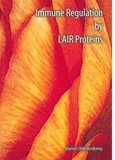Immune regulation by LAIR proteins

Olde Nordkamp, Marloes
- Promoter:
- Prof.dr. L. (Linde) Meyaard
- Research group:
- Inhibitory receptor lab
- Date:
- September 5, 2013
- Time:
- 12:45 h
Summary
Inhibitory immune receptors are important for the balance of the immune system. They are differentially expressed by various immune cells and regulate the immune system by counter acting activation signals. This thesis focuses on the role of the inhibitory receptor leukocyte associated immunoglobulin-like receptor-1 (LAIR-1) and it soluble family member LAIR-2 in immune regulation. We show that urine from patients suffering from Rheumatoid Arthritis contains significantly more sLAIR-1 (a form of LAIR-1 that is shed of the cell surface) and LAIR-2. Levels of LAIR-2 correlated significantly with the erythrocyte sedimentation rate, a known marker for inflammation. These data indicate that sLAIR-1 and LAIR-2 might be suitable biomarkers for inflammatory disease. We found that sLAIR-1 correlates with compliance of the total respiratory system at age one month, when measured in amniotic fluid of term pregnancies. Interestingly, amniotic fluid LAIR-1 levels correlate poorly with, and are distinct from, other cytokines measured which resemble the 'acute inflammation gene expression signature'. This might indicate that LAIR-1 is not ‘just another’ inflammatory biomarker, but reflects the activation state of the immune system in a distinct manner. For several years we know now that the ligand of LAIR-1 is collagen. In this thesis we show that the collagenous domain containing surfactant protein-D (SP-D) and the collagenous domain containing mannose binding lectin (MBL) can also function as ligands for LAIR-1. The discovery that the (novel) ligands of LAIR-1 are constitutively available leads to the conclusion that LAIR-1 mediated immune regulation is not only important in situations where tissue damage has exposed collagen, but also plays a role in the regulation of the immune system in steady state. We show for the first time that ligation of LAIR-1 by collagen or SP-D on a neutrophillic cell line is able to limit the oxidative burst generated by triggering of the Fcα receptor, thereby identifying a novel regulatory pathway for the immunoregulatory SP-D molecule. We also show high affinity binding of a recombinant form of LAIR-2 to C1q and MBL. Binding of recombinant LAIR-2 to C1q and MBL inhibits the activation of the classical and lectin pathway of the complement system. Recombinant LAIR-2 could potentially be of future use as a therapeutic in situations where it is desirable that the complement system is locally inhibited, such as after organ transplantation or cardiac arrest. In conclusion, in this thesis we investigated immune regulation by cell expressed LAIR-1 and soluble LAIR proteins. We found that LAIR-1 ligation can be mediated by several ligands and show for the first time that ligation of the receptor is able to inhibit the oxidative burst. Furthermore, we investigated the potential use of sLAIR-1 and LAIR-2 as biomarkers in inflammatory disease or amniotic fluid. We show that recombinant LAIR-2 is able to inhibit the two major pathways of the complement cascade and might be a potential therapeutic. All these data combined show that although there are many inhibitory immune receptors, they are involved in many different processes and one can play a major role in immune regulation.